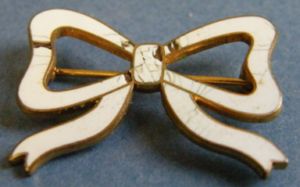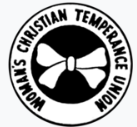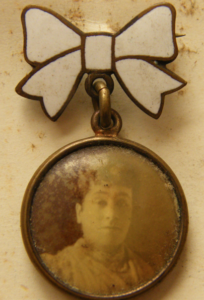The British Women’s Temperance Association (BWTA) was founded in Newcastle-upon-Tyne in 1876, at the height of the temperance movement in the 19th century. The organisation still exists today as the White Ribbon Association. Although we no longer promote total abstinence from alcohol as our predecessors once did, we still work to promote healthy lifestyles within the community.
 We have a valuable archive containing records from the foundation of the association, as one of the foremost women’s temperance societies right up to the present day. It was whilst working with this archive, that I became interested in the origins of the white ribbon as badge and symbol of the BWTA.
We have a valuable archive containing records from the foundation of the association, as one of the foremost women’s temperance societies right up to the present day. It was whilst working with this archive, that I became interested in the origins of the white ribbon as badge and symbol of the BWTA.
Woman’s Christian Temperance Union
 It appears that we need to look across the Atlantic in respect of the white ribbon symbol, to the temperance movement in America and in particular to the Woman’s Christian Temperance Union (WCTU), which was founded in 1874. From this first National Union, the World’s Woman’s Christian Temperance Union (WWCTU) was formed. The WWCTU was formed in order to bring women together from societies across the globe in the cause of temperance.
It appears that we need to look across the Atlantic in respect of the white ribbon symbol, to the temperance movement in America and in particular to the Woman’s Christian Temperance Union (WCTU), which was founded in 1874. From this first National Union, the World’s Woman’s Christian Temperance Union (WWCTU) was formed. The WWCTU was formed in order to bring women together from societies across the globe in the cause of temperance.
An article in the 1915 White Ribbon magazine by Margaret Winslow (which originally appeared in Canadian White Ribbon Tidings), provides an account of the ‘Birth of the White Ribbon’.
At one of the earliest WCTU meetings held in Chicago in October 1877, it is recorded that a whole afternoon was devoted to the discussion of a suitable badge for the organisation. The wearing of a coloured ribbon had already been established by other temperance groups in America.
Debating the ribbon
Various suggestions were put forward for consideration including a red ribbon, which had already been adopted by Dr Reynolds, a temperance evangelist. Blue was also proposed, which was the colour marking out the converts of America’s Francis Murphy, those of the Blue Ribbon movement or Gospel Temperance, as it was known. The combined colours of red, white and blue were also suggested by Frances Willard of the WCTU, as a way of enlisting the sympathies of patriotic Americans to the temperance cause.
In a bid to resolve the discussion, Margaret Winslow retrospectively described in the 1915 article, how she had been at an early temperance meeting on a beach with ten thousand people. Above them fluttered a white pennon on a flagstaff, bearing the words ‘Holiness to the Lord’. At that point a steamer passed by with men on board and in the water was ‘a great shoal of frightened fish, radiant in the sunlight, making for the shore.’ Margaret saw this as a symbol of the persecuted, sinful, and suffering of earth taking refuge at the feet of God. ‘Now then’, she said, ‘let us choose white, which besides the convenience of its attainment, universally represents purity and is the union of all colours.’ Following her inspired speech on the meaning of the symbolism of the white ribbon as the badge of the union, the suggestion was adopted by the WCTU. The imagery of the white ribbon encircling the world in the cause of temperance had begun.
Blue Ribbon Army
The Blue Ribbon Gospel Temperance movement came to England from the USA in 1877, just after the formation of the BWTA in 1876 and at a time when the WCTU were debating the colour of their own temperance ribbon. It is recorded that by the end of the 1880’s, over a million had signed the pledge in England and wore the blue ribbon. Other temperance groups picked up the idea of wearing ribbons until ‘there was a great proliferation of these badges in all colours’. A yellow ribbon was even the badge of an anti-temperance organisation.
The wearing of coloured ribbon as a symbol of one’s membership to a temperance organisation, would not have been an entirely new idea to the women of the BWTA.
Lady Henry Somerset – BWTA President 1890-1903
 It would have been a natural progression for the BWTA to become affiliated to the World WCTU. Third President of the BWTA, Mrs Margaret Bright Lucas became first President of this world ‘umbrella’ union in 1884. Other prominent members of the BWTA followed in her footsteps as President, including Lady Henry Somerset and Rosalind Countess of Carlisle. Lady Henry Somerset and Frances Willard, second President of the WWCTU formed a close friendship, developing as contemporaries within the World’s Woman’s Temperance movement.
It would have been a natural progression for the BWTA to become affiliated to the World WCTU. Third President of the BWTA, Mrs Margaret Bright Lucas became first President of this world ‘umbrella’ union in 1884. Other prominent members of the BWTA followed in her footsteps as President, including Lady Henry Somerset and Rosalind Countess of Carlisle. Lady Henry Somerset and Frances Willard, second President of the WWCTU formed a close friendship, developing as contemporaries within the World’s Woman’s Temperance movement.
In 1888 Frances Willard of America, wrote a letter to her ‘beloved sisters’ of the WWCTU in England, about the ‘great sisterhood of the White Ribbon.’ She urged her temperance sisters of the BWTA to wear the white ribbon as a badge of patriotism, purity and peace. They would do so by wearing a white ribbon on their left hand side above their heart. Members of the BWTA saw themselves as guardians of the white ribbon badge in this country, however it may have taken some time for this to become established within the association.
Wearing the badge with pride
As an affiliated society to the WWCTU, members of the BWTA having signed the pledge of total abstinence from alcohol, were entitled and encouraged to wear the White Ribbon and were known as ‘White Ribboners’. It was recognised that the badge could attract attention and public interest in the work of the BWTA, whilst also establishing a spirit of comradeship in the cause of temperance. It was a simple and distinguishing mark of their cosmopolitan work, whilst also affording recognition and friendship between members. Whilst Lady Henry Somerset caused some controversy within the BWTA, in respect of what was perceived by some as the ‘Americanisation’ of the association, she forged forward with these links.
During Lady Henry Somerset influential presidency in the 1890’s, the Constitution of the BWTA was amended to include the wording, ‘A bow of white ribbon shall be the badge of the society,’ It was expected that members should wear the badge at branch meetings and on all related public occasions. In fact, it was desirable to wear the badge at all times.
In 1896 Agnes Slack, another prominent member of the BWTA, lamented that during her travels around the UK she had noticed that the White Ribbon badge was being used ‘most inefficiently’ by members. She recognised the advantages of being ‘one of a large army’. She believed that if everyone who was entitled to wore the badge, then ‘a much greater impression would be produced on society with regard to the strength and influence of the BWTA, and the mere sight of it constantly leads to enquiries, explanations, argument, the removal of doubts, and through these the strengthening of the movement.’
White Ribbon magazine
In 1897 Lady Henry Somerset further cemented the significance of the white ribbon and the association’s relationship with the WWCTU, by publication of the BWTA’s monthly magazine, which was now to be known as The White Ribbon and which continued to be published into the 21st century. The name was used by WCTU unions around the world for their news magazine.
Where pieces of white ribbon had been worn on the left hand side, now small white ribbon enamelled badges of differing designs were regularly advertised for sale in the monthly magazine and members were encouraged to purchase them.
Image from White Ribbon magazine 1901
The symbolism of the white ribbon was firmly planted into the fabric of the association from the earliest days and has been ever since, with the name of the association today still honouring that tradition.



